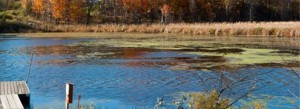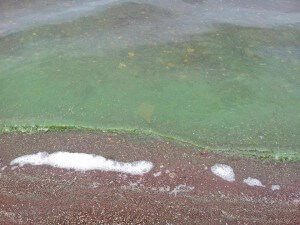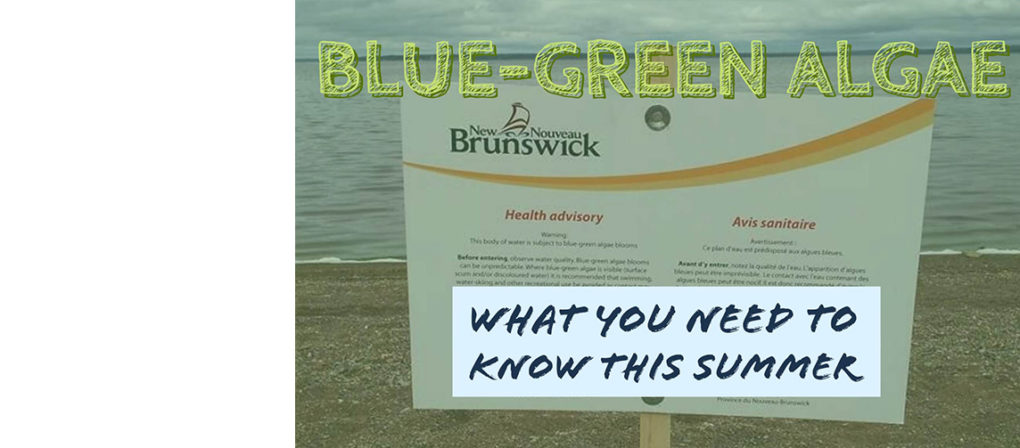
Warm, slow moving water might sound inviting for a relaxing dip – but if this sounds like the conditions at your favourite lake, you may want to check this site before jumping in.
That’s where you’ll find the provincial government’s health advisories, including advisories of blue-green algae blooms at New Brunswick lakes.
Algae season is in full swing and that means swimmers need to be extra cautious when cooling off in our lakes. The Department of Health issued the first blue-green algae advisory of the 2018 season, for Lake Nictau in Mount Carleton Park, on July 14.
Despite the name, ‘blue-green’ algae isn’t a just a colorful description of algae – in fact, blue-green algae are not an algae at all.
What we call blue-green algae are actually photosynthetic cyanobacteria that early scientists mistook for algae. When the conditions are right, individual microscopic cells collectively form a vibrant, electric blue-y, green-ish “bloom.”
Shallow, slow moving, warm water makes ideal breeding grounds for blue-green algae; lakes in the summertime are often ripe with these conditions, and some experts say that climate change (warming waters, heavier rainfalls) is also contributing to the bacteria’s growth.
Scientists from Bowling Green State University in Ohio have even studied links between algae blooms and the use of herbicides containing glyphosate around Lake Erie, which has experienced blooms so large they can be seen from space.

Although blue-green algae occurs naturally, a bloom can also be triggered by pollution in a body of water, such as phosphorus – a common nutrient in our day-to-day lives.
Some of the main sources of phosphorus getting into our waters include:
- Runoff from large scale farming operations: manure and fertilizers that are nutrient-rich (and containing phosphorus) can make their way into our rivers and lakes.
- Runoff from large-scale forest clearcuts: when large forestry companies clear cut vast swaths of our forest, it can disturb the phosphorus that occurs naturally in the soil, which then makes its way into rivers and lakes during heavy rains. We can prevent this by changing laws to make buffers between forestry operations and rivers/lakes wider and by making clear cuts smaller.
- Septic systems: septic systems that store and treat sewage and household wastewater on individual rural and shoreline properties can leach phosphorus and other contaminants into nearby water bodies when not properly installed, maintained, or monitored.
- Runoff: rain and snowmelt can carry a combination of phosphorous and other contaminants directly into our waterways and also our storm sewer systems.
- Atmospheric deposition: phosphorus can also make its way into water bodies from the air by wind, rain and snowfall from such activities as exposed landfill and compost heaps, coal combustion, and dust from quarries, agricultural fields and unpaved roads.
If you spot a bloom near your favourite summer swimming spot, it’s best to stay out of the water. Certain strains of cyanobacteria contain toxins which are poisonous and can cause skin irritations (in the form of rashes, hives, or skin blisters), and can result in illness among people and animals.
Unfortunately, blue-green algae blooms occur most often in the summer when we want to escape the heat and dive in to a refreshing body of water. Although blue-green algae can occur naturally, there are a few things you can do to prevent blooms from happening:
- What you put down the drain can end up in our waters. Switch to phosphorus-free cleaning products like dishwashing detergents.
- What you put on your lawn or garden can end up in our waters. Avoid over using fertilizers and try non-toxic alternatives when possible.
- Make sure your septic system is checked and cleaned every five years or so.
- Leave your shoreline natural and if necessary restore the shoreline with fast growing vegetation to prevent erosion and help absorb nutrients before they enter the water. Wetland areas are especially important in filtering out nutrients like phosphorus and other contaminants.
For more information and updates on algae advisories, visit the provincial Public Health Advisories and Alerts page.

